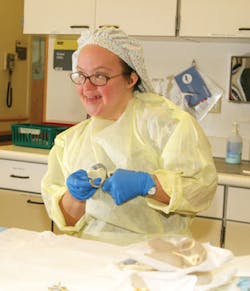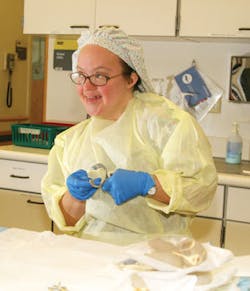A Perfect Fit
A Cincinnati dental clinic took a chance on Annie Sublett. Ten years later, this special sterilization assistant is a big part of the team.
Sterilization assistant Annie Sublett of Cincinnati comes to work every day, clocks in, works on her feet for eight hours, clocks out, and goes home.
“And that’s more than I can say of some employees,” says Joanne Shumate, clinical operations supervisor and manager at the 15-chair hospital dental clinic where Annie works. “She has her moments, but for the most part, Annie does very well. I think she’s only missed two days of work in the last 10 years.”
Everyone at the dental clinic of the Cincinnati Children’s Hospital Medical Center is especially appreciative of Annie, because she’s not just an ordinary dental assistant. Annie has Down Syndrome.
- Joanne Shumate, clinical operations supervisor and manager
Stop and think for a minute about all the things a sterilization assistant does. She accepts contaminated, jumbled, sometimes bloody instrument trays and cassettes, then sorts, cleans, packages, sterilizes, and stores them. She is mindful of infection control and biologic monitoring. She fills out paperwork and keeps her area clean. She uses and maintains various types of sterilizers, stocks supplies, and can tell the difference between a Hollenback and a Gracey.
“Not only can Annie tell you the name of every instrument,” Shumate says, “but she can tell you how it’s used, how it’s sterilized, and where it’s kept. If an assistant or hygienist needs a particular instrument, Annie can pull it and take it to them.”
Isn’t that amazing?
Taking a chance
Annie came to her job through Project SEARCH, a collaboration between the Great Oaks Institute of Technical and Career Development, and the Bureau of Vocational Rehabilitation Services. The project is a nationally recognized and replicated program that provides comprehensive employment, job retention, and career advancement services for adults with disabilities. Two years ago, the program won a New Freedom Initiative Award from the U.S. Department of Labor.
When Project SEARCH first began at the hospital 10 years ago, employment coordinator Jennifer Linnabary had a conversation with Erin Riley, then director of the hospital’s emergency department. Linnabary told Riley that Project SEARCH was looking for a sterilization assistant for the dental clinic.
“I think I have just the person for you,” Riley said. She recommended Annie Sublett, a stock clerk in the emergency department, for the new program.
Riley, Linnabary, and Shumate were not sure about Annie’s capabilities at first, but they decided to give her a chance to work in the dental clinic with a job coach.
For three months, the coach worked one on one with Annie. “It was frustrating for the first six weeks,” Shumate remembers, “because Annie had no idea what she was doing or what she was getting into. But we had a very good job coach, and we were able to come up with a plan.”
The coach made up flash cards that illustrated each instrument and its function. “Every day, we’d teach her something else.”
After another six weeks, Annie began to function more and more on her own, and the coach was phased out. “It really wasn’t that difficult,” Shumate remembers. “It wasn’t the worst nightmare even at the start, and Annie’s come a long way over the years.”
After its success with Annie, Project SEARCH continued to place disabled workers at the hospital, and today there are 60 such workers. Some, like Annie, work in sterilization areas. Others are patient transporters or food service workers, and some are in materials management.
All About Annie
Annie lives with her father, who brings her to work most days. She’s happy to talk about the things that are important to her -- family and work.
“I have three brothers,” she says proudly, “and five sisters. I’m number nine in the family, and I have 22 nieces and nephews. My boyfriend’s name is Tom, and he works at Phoenix. He does screen printing.
“I like my job,” Annie continues. “My favorite thing is all the people I work with.”
“She gets along well with her co-workers,” agrees Shumate. “She laughs and talks with all the attendings and residents, and there are several assistants she really likes. They go to lunch together. She goes to all the staff meetings and continuing ed programs, and is included in everything at the clinic. I’d say Annie is a nine and a half (out of 10) at getting along with people.”
She likes to say hello to patients in the clinic, highlighting names on the schedule, and she enjoys seeing fellow employees’ children.
Annie is very confident about her job. “I’ve been here 10 years, so I know what to do. When instruments come in, I have to rinse them, put them in the wash cycle, then rinse and dry them. I dump them all out on the table to sort them. I have two autoclaves and one Dentronics unit.
“Every Friday, I lubricate the handpieces. There are two kinds of handpieces, and two kinds of instrument cassettes. If the cassettes are too big, I send them downstairs to my friend, Jill.”
Jill, another Project SEARCH success story, does sterilization for the operating rooms, and has bigger autoclaves.
Shumate is very impressed with Annie’s job skills. “Annie is responsible for keeping her cabinets clean and organized. Everything is very neat at all times. Her counters are always clean, and her cabinets are always wiped down. Infection control is an ongoing process here, and Annie is very aware of it. And knock on wood, she’s never had an accident. She knows how to vent the autoclaves, to wait until the temperature drops to zero, then to crack the doors and let the steam come out.
“She handles her own inventory, and even helps me sort paperwork. She’s above average in reading and comprehension.”
With a little faith, a little creative thinking, and a lot of supportive coaching, Annie has become a valuable employee at the hospital dental clinic. Linnabary and Shumate are as proud of Annie’s success as she is herself.
“I’ve learned a lot about the characteristics of Down Syndrome in the past 10 years,” says Shumate, “and all I can say is that Annie does a very good job.”
Biographical Sketch
Cathy Hester Seckman, RDH, is a frequent contributor to RDH Magazine (a sister publication of Dental Office). She is based in Calcutta, Ohio. Besides working in a pediatric dental practice, Seckman is a prolific freelance writer and book indexer. She can be reached at [email protected].
What is Down Syndrome?
Down Syndrome was first described by John Langdon Down, an English physician, in 1866. French physician Jerome Lejeune, in 1959, further described the syndrome as a chromosomal anomaly in which 47 chromosomes are present instead of the usual 46.
More than 350,000 people in the United States, of all ages and races, have Down Syndrome. It occurs in one out of every 733 live births. A person with Down Syndrome experiences mild to moderate cognitive delays, and may have low muscle tone and hearing or vision problems. Other health conditions can include heart, intestinal, or ear and respiratory defects.
Much effort has been expended in recent years helping Down Syndrome people reach their full potential. Some live independently or in group homes, and many, like Annie, hold responsible jobs.


